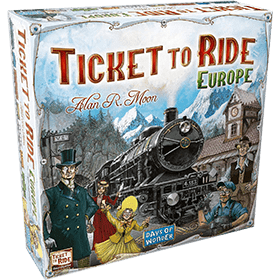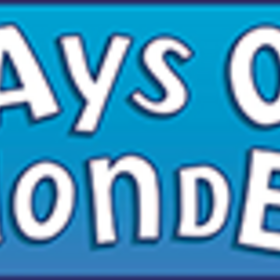Ticket to Ride: Europe TTR, TTRE
 From the craggy hillsides of Edinburgh to the sunlit docks of Constantinople, from the dusty alleys of Pamplona to a windswept station in Berlin, Ticket to Ride Europe takes you on an exciting train adventure through the great cities of turn-of-the-century Europe.
From the craggy hillsides of Edinburgh to the sunlit docks of Constantinople, from the dusty alleys of Pamplona to a windswept station in Berlin, Ticket to Ride Europe takes you on an exciting train adventure through the great cities of turn-of-the-century Europe.
Number of players: 2 - 5
Game duration: 13 mn
Complexity: 2 / 5
Play Ticket to Ride: Europe and 988 other games online.
No download necessary - play directly from your web browser.
With your friends and thousands of players from the whole world.
Free.

Play Ticket to Ride: Europe and 988 other games online.
No download necessary - play directly from your web browser.
With your friends and thousands of players from the whole world.
Free.

Rules summary
Beginning of the Game
Players start the game with four train cards in their hand. Before taking their first turn, players must choose which Destination Tickets they will keep from among those they were initially dealt. Each player must keep a minimum of two tickets although they may keep more. Put any Destination Tickets you wish to discard back in the game box without letting any of the other players see them. The Tickets that are put away may either be long routes or regular ones. The tickets you decide to keep are held until the end of the game.
Game End
Each player starts the game with 45 train cars in their player color. When any one player’s stock of colored plastic trains gets down to two trains or less at the end of their turn, each player, including that player, gets one final turn. The game then ends and players calculate their final scores.
Object of the Game
Points can be scored by:
- Claiming a Route between two adjacent cities on the map
- Successfully completing a Continuous Path of routes between two cities listed on your Destination Ticket(s)
- Completing the Longest Continuous Path of routes to win the European Express Bonus card (+10 points, ties are friendly)
- For each unused Train Station kept in reserve at the end of the game (+4 points each)
Points are deducted from the players’ total score for each of their Destination Tickets that are not successfully completed by the end of the game.
Player Turn
On each turn, the active player must perform one (and only one) of the following four actions:
- Draw Train Car Cards – The player may draw two Train cards (or just one, if the card they select is a face-up Locomotive)
- Claim a Route – The player claims a route on the board by playing a set of Train cards from their hand that match the color and quantity of the spaces that make up the route. They place one of their colored trains on each space, and score the number of points indicated on the Route Scoring Table for that route’s length
- Draw Destination Tickets – The player draws three Destination Tickets from the top of the Tickets deck, and must keep at least one of them
- Build a Train Station – The player may build a Station in any city that does not yet have one. To build their first Train Station, the player plays one Train card of any color and places one of their Train Stations on that city. To build their second station, the player must play a set of two cards of the same color, and to build their third station, a set of three cards of the same color. Only one station is allowed per city.
Scoring points from routes
When a player claims a route, they immediately score the number of points indicated for the length of the route just claimed.
| Route Length | Points Scored |
|---|---|
| 1 🚃 | 1 |
| 2 🚃🚃 | 2 |
| 3 🚃🚃🚃 | 4 |
| 4 🚃🚃🚃🚃 | 7 |
| 6 🚃🚃🚃🚃🚃🚃 | 15 |
| 8 🚃🚃🚃🚃🚃🚃🚃🚃 | 21 |
Double-Routes
Some cities are connected by Double-Routes. These are routes whose spaces are parallel and equal in number from one city to the other. One player can never claim both routes between the same cities during the course of the game.
Be aware of routes that are partially parallel to each other but are linked to different cities. These are not double-routes.
Locomotives
Locomotives are multi-colored train cards, and act as a wild colored train card. Locomotive cards can be played along with any set of cards when claiming a route. They are also vital to claiming Ferry routes (see Ferries).
Ferries
Ferries are special Gray routes linking two adjacent cities across a body of water. They are easily identified by the Locomotive icon(s) featured on at least one of the spaces making the route.
To claim a Ferry Route, a player must play a Locomotive card for each Locomotive symbol on the route, and the usual set of cards of the proper color for the remaining spaces of that Ferry Route.
Tunnels
Tunnels are special routes that are easily identified by the special tunnel marks and outlines surrounding each of their spaces.
When attempting to claim a Tunnel route, a player first lays down the number of cards required by the length of the route. Then the top three cards from the Train Card draw pile are turned face-up. For each card revealed whose color matches the color of the cards played to claim the Tunnel, an additional card of the same color (or a Locomotive) must now be played from their hand. Only then can the player successfully claim the Tunnel route.
If the player does not have enough additional Train cards of the matching color (or does not wish to play them), they take all their cards back in their hand, and their turn ends.
At the end of the turn, the three Train cards revealed for the Tunnel are discarded.
Train Stations
A Train Station allows its owner to use one, and only one, of the routes belonging to another player, into (or out of) that city to help them connect the cities on their Destination Tickets.
Stations may be built on any unoccupied city, even if it currently has no claimed routes into it. Two players may never build a Station in the same city.
Each player may build a maximum of one Station per turn, and three Stations throughout the course of the game.
To build their first Station, a player plays and discards one Train card from their hand, and places one of their colored Train Stations on the chosen city. To build a second Station, the player must play and discard a set of two cards of any one color; and to build their third station, a set of three Train cards of any one color. As usual, you can replace any number of cards by Locomotives.
If a player uses the same Station to help connect cities on several different Tickets, they must use the same route into the city with the Station for all of those Tickets. The Train Station owner does not need to decide which route they will use until the end of the game.
A player is never required to build any Stations. For each Station a player has not used, four points are added to their score at the end of the game.


